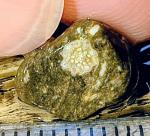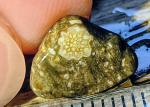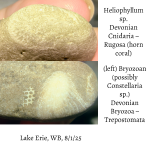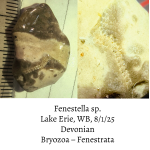Bryozoa
Bryozoans, sometimes called “moss animals,” are tiny colonial invertebrates that have been building intricate skeletons for over 450 million years. Though each individual organism is microscopic, bryozoans live together in colonies that create branching, fan-like, or encrusting structures. These colonies are made of calcium carbonate and preserve beautifully as fossils in the Ordovician to Devonian rocks of Northwest Pennsylvania and Northeast Ohio.
Bryozoan fossils often resemble lace, twigs, or net-like patterns and can be mistaken for corals. However, unlike corals, bryozoans are not cnidarians but belong to their own phylum, Bryozoa. They were filter feeders, extending tiny tentacles called lophophores to collect plankton from the water.
Because of their abundance and distinctive forms, bryozoans are an excellent index fossil group, helping geologists determine the age of rock layers. Their delicate structures make them a favorite among collectors, offering a fascinating look into the diverse life of ancient seas.





